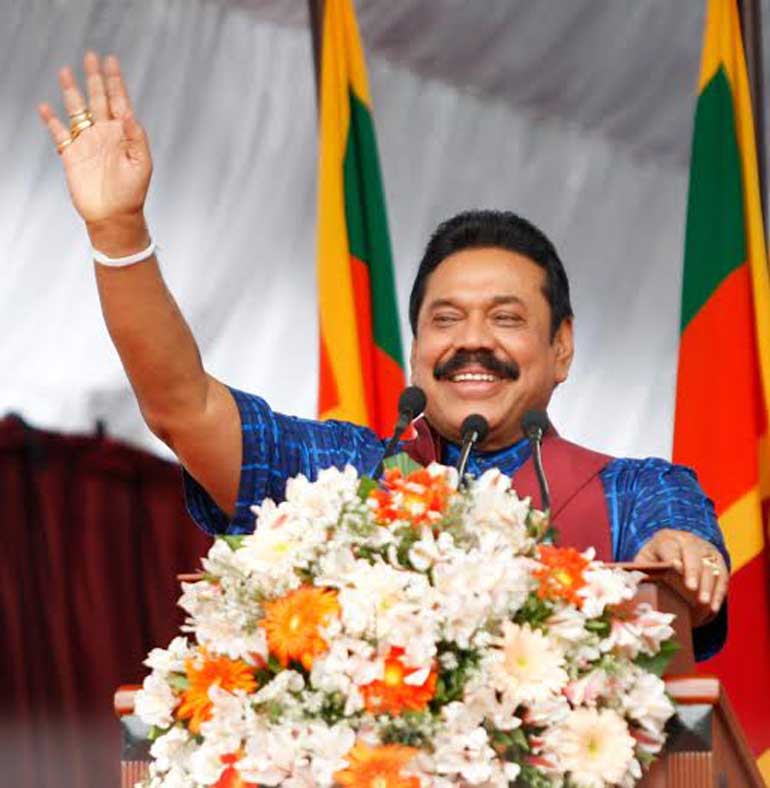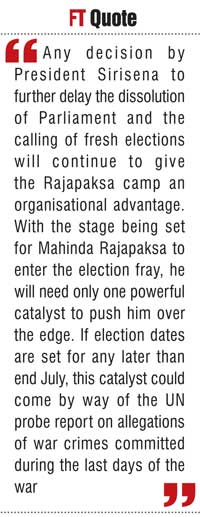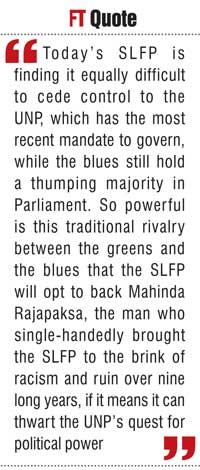Saturday Nov 08, 2025
Saturday Nov 08, 2025
Thursday, 11 June 2015 00:00 - - {{hitsCtrl.values.hits}}
 Former President Mahinda Rajapaksa at a recent rally
Former President Mahinda Rajapaksa at a recent rally
Former Defence Secretary Gotabaya Rajapaksa, arguably the previous regime’s most powerful man, may be under fire from a plethora of investigations into procurements and dealings during his tenure as chief accounting officer for the Ministry of Defence. But nearly six months after his brother’s stunning election defeat rendered him jobless and without immunity, some of the bravado appears to be returning. The former President’s favourite younger brother is stepping out of the shadows again, as the former ruling family’s political machinery kicks back into gear for another crucial election battle.
Colombo’s ranking by the MasterCard Global Destinations Index 2015 as the world’s fastest growing city for tourism led to a series of postings on the ex-official’s official Facebook page. “Over the next few weeks, I look forward to sharing some thoughts on this site about the urban development work carried out by the previous Government between the end of the conflict and January 2015,” the former Defence Secretary said in his Facebook posting.
A few days ago, looking casual in a t-shirt at his Nugegoda residence, with a large portrait of President Rajapaksa and a bronze sculpture of Avalokatheshwara at his side, Gotabaya Rajapaksa spoke to a private television station that was highlighting the achievement. During the interview, he warned against squandering the development successes in Colombo by the failure to maintain his parks, jogging tracks and shopping precincts that best serve the capital’s upper middle classes.
The Rajapaksa brothers, who held Sri Lanka in authoritarian thrall for nine long years, fancy themselves great statesmen. Gotabaya Rajapaksa speaks with rehearsed eloquence about the defeat of terrorism and his efforts to transform Colombo into a modern and liveable city. The reality is much darker. Like all Rajapaksa regime ‘good works’, the development of the capital, under the former Defence Secretary’s watchful eye, had an ugly underbelly.
Thousands of Colombo residents were forcibly evicted, their homes razed and livelihoods destroyed when the former Defence Secretary began his beautification drive in the city. Backhoes demolished low-income housing settlements while military personnel threateningly observed the process. When residents kicked up a fuss and argued with the authorities, leading members of that community were abducted by white van. A suppliant Supreme Court had removed all hope of redress for the victims of an urban beautification drive.
 When Gotabaya Rajapaksa complains about the awful state of his beloved urban parks and jogging tracks, it’s easy to forget that he used thousands of armed forces personnel to sweep and maintain his special projects. Under Secretary Rajapaksa, Sri Lanka became one of the only countries since the end of World War II to swell the ranks of its military rather than demobilise after the end of a conflict. No longer fighting LTTE separatists in the north and east, 300,000 military personnel had to be gainfully employed. From celebrated war heroes and humane patriots, they became road-sweepers, waiters and janitors, almost invisible and constantly confronted by the opulence of the middle classes, revelling in the pleasures of post-war Colombo.
When Gotabaya Rajapaksa complains about the awful state of his beloved urban parks and jogging tracks, it’s easy to forget that he used thousands of armed forces personnel to sweep and maintain his special projects. Under Secretary Rajapaksa, Sri Lanka became one of the only countries since the end of World War II to swell the ranks of its military rather than demobilise after the end of a conflict. No longer fighting LTTE separatists in the north and east, 300,000 military personnel had to be gainfully employed. From celebrated war heroes and humane patriots, they became road-sweepers, waiters and janitors, almost invisible and constantly confronted by the opulence of the middle classes, revelling in the pleasures of post-war Colombo.
Ironically, while the Rajapaksa regime was intent on building a powerful military state, these frustrations in the military rank and file contributed to their defeat earlier this year. President Rajapaksa lost the island-wide postal vote on 8 January, the early ballots cast by public servants and military personnel serving outside their home electorates. As far as the ordinary soldier is concerned, the decision appears to have paid off.
Long and painful road to democratisation
President Maithripala Sirisena delivered on his election promise to restore dignity to the armed forces and ensure they do not remain slaves to the wealthy classes. Today city clean-up has been entrusted again to the municipal worker, prone to strikes and lethargy. Yet the Sirisena administration appears to have decided that the odd stray leaf on a jogging track or a less than perfectly manicured lawn is worth all that has been reclaimed since 8 January. Extricating the military shadow from every area of civilian life and rebuilding institutions has been a work in progress over the past six months, but it remains a cornerstone of the re-democratisation process undertaken since the defeat of the Rajapaksa regime.
Obviously this irks the former Defence Secretary and other top members of the ex-regime, who view the process to restore independence to State institutions and confine the military to barracks as an attempt to dismantle the powerful military state that was under construction. Yet even they know that strong institutions cannot be rebuilt in six months, after they have been under assault for the better part of nine years. Half-a-year after the election, with their policy to refrain from purging institutions of officials loyal to the Rajapaksa ruling cabal, the new Government is only just scratching the surface of what will be a long and painful process. The Rajapaksas realise therefore that reassembling their preferred version of the State is only one crucial election away.
So the former ruling family is refusing to go down without a fight. Corruption investigations may keep the ex-regime’s misdeeds alive and well in public memory, but the Rajapaksa camp are hoping to be restored to power by appealing to the people’s more tribal instincts. For four months after the election, President Rajapaksa licked his wounds in private, allowing the movement calling for his return to power to gather quiet momentum. He contented himself with playing puppeteer and watching members of his former ruling alliance wreak havoc in Parliament to scuttle the new Government’s reform agenda. In this the UPFA rebels from the ‘Mahinda camp’ found great allies in the old guard SLFP, which held a gun to the head of the minority UNP Government and forced dilution of the 19th Amendment to the Constitution, which aimed to reduce presidential powers and restore independence to key State institutions.
 A similar hostage-taking situation is already building around the 20th Amendment, which is set to be gazetted tomorrow (12) after the Cabinet this week approved Prime Minister Ranil Wickremesinghe’s formula for electoral reform. UPFA General Secretary Susil Premajayanth, whose allegiances have recently been in question, has already indicated that the Opposition disagrees with the reform proposal in its current form and will insist upon amendments. It remains to be seen if President Sirisena will permit the UPFA and his own SLFP to strong-arm his administration once more, imposing its will by force through its huge majority when the amendment comes up for debate in Parliament.
A similar hostage-taking situation is already building around the 20th Amendment, which is set to be gazetted tomorrow (12) after the Cabinet this week approved Prime Minister Ranil Wickremesinghe’s formula for electoral reform. UPFA General Secretary Susil Premajayanth, whose allegiances have recently been in question, has already indicated that the Opposition disagrees with the reform proposal in its current form and will insist upon amendments. It remains to be seen if President Sirisena will permit the UPFA and his own SLFP to strong-arm his administration once more, imposing its will by force through its huge majority when the amendment comes up for debate in Parliament.
Dissolution delays
The UPFA strong-arm tactics, buttressed by SLFP support and President Sirisena’s desire to conduct the business of governance through consensus, has significantly strengthened the Rajapaksa hand. The mandate for President Sirisena’s 100-day programme of work ended on 23 April, nearly two months ago. The 19th Amendment was passed one week behind that deadline, but not even the fulfilment of that crucial election promise led to the dissolution of Parliament and the end of the UNP-led minority Government. In fact, during the battle for the passage of 19A, President Sirisena brokered a compromise with the SLFP to secure their crucial votes to enact the amendment, by pledging to pass the 20th Amendment on electoral reform before the tenure of the current Parliament came to an end.
Nearly two months later, President Sirisena’s minority Government faces another battle royale over 20A, this time poised for a fight with not only the SLFP and the Mahinda faction of the UPFA, but also minor parties that view the draft amendment as inimical to their political interests. To compound matters, the UPFA has flexed its muscles once more with a no-confidence motion against Prime Minister Wickremesinghe submitted to the Speaker, already holding the signatures of 112 MPs, only one short of a simple majority.
While this drama unfolds between the Sirisena administration and the official Opposition, and with the UNP heavily preoccupied with matters of governance and kick-starting its own election machinery, the former President has been quietly stepping into the light. The distractions of Parliamentary battles and President Sirisena’s decision to delay calling elections to placate his own party have created the space necessary for the Rajapaksa faction to mobilise and convince their star candidate to step into the fray. Today, the former President has media spokesmen and a well-oiled propaganda machinery all set to get back to work. Offices and staff are being set up to conduct strategic planning for the Rajapaksa rebirth.
 Renaissance man
Renaissance man
Where once he was a no-show at rallies calling for his return or he sent notes to be read out to his supporters, today President Rajapaksa rarely misses an opportunity to take centre-stage. Daily visits to temples have become media feeding frenzies. And this week, in the guise of commemorating former SLFP Minister C.V. Gooneratne who was killed by the LTTE in 2001, President Rajapaksa held a large meeting in Dehiwala where he raged against the present Government for squandering the war victory.
The meeting was widely publicised, with large hoardings and posters all over the city, indicating that the Rajapaksa spending power remains intact. Powerful players, in the form of foreign governments and interested businessmen, are reported to be bankrolling the campaign to return President Rajapaksa to power. Fear-mongering about concessions to the Tamils and the Muslims has continued apace since the conclusion of the presidential election, and the new Government is also consistently accused of being the pawn of Western Governments.
With the lines blurred between Government and Opposition in the current Parliament, Mahinda Rajapaksa remains the most existential threat to the present administration. It is their tribal, Sinhala hegemonic vision for Sri Lanka that is the ideology constantly juxtaposed against the Sirisena administration’s more liberal attitudes and ‘benevolence’ towards the minorities. In a murky political landscape, the Rajapaksa coterie, their relatives and cronies, have unwittingly emerged as the ‘true’ alternative to the ‘yahapalanaya’ Government. Entrenched one way or the other in the Sirisena camp, the SLFP, JVP and JHU fail to offer a real difference from the present status quo.
This is not to say that the Sirisena administration is suffering a massive erosion of popular support, but simply that it is not the SLFP which will obtain the lion share of Mahinda Rajapaksa’s ‘58 lakhs’ but Mahinda Rajapaksa himself, should he contest, or possibly an alliance to which he extends his public support. With questions being raised about Premajayanth’s loyalties to the Sirisena camp, the Mahinda faction may even have the option of contesting under the betel leaf, a symbol that has become synonymous with Rajapaksa leadership of the SLFP-led UPFA coalition. As General Secretary of the UPFA, Premajayanth is the custodian of the UPFA registration and symbol. For the Mahinda camp, winning his support could mean the difference between fielding candidates under the familiar betel leaf symbol that has been tremendously successful for the Rajapaksa regime until 8 January, or registering an all-new party to contest the parliamentary polls.
The Rajapaksa trump card
Any decision by President Sirisena to further delay the dissolution of Parliament and the calling of fresh elections will continue to give the Rajapaksa camp an organisational advantage. With the stage being set for Mahinda Rajapaksa to enter the election fray, he will need only one powerful catalyst to push him over the edge.
If election dates are set for any later than end July, this catalyst could come by way of the UN probe report on allegations of war crimes committed during the last days of the war. The report is due to be released during the UN Human Rights Council sessions in Geneva in September. The UN High Commissioner for Human Rights promised in February that the deferral of the investigation report would be ‘one-time only’, indicating that his office would not offer the Sri Lankan Government any further reprieve. With UNHRC September sessions commencing on 14 September, the report is likely to be delivered to the Permanent Mission of Sri Lanka to the UN in Geneva by mid-August, to allow the Government time to draft a response. Unofficially released copies of the report therefore, are likely to be in circulation by August.
The additional six months granted to investigators to fine-tune the report that was initially due for release in March 2015 may have made the document more coherent and comprehensive, sources with knowledge of the drafting process told the Daily FT. There also appears to be certainty that several names – at least 40 – will be cited in the UN report, and many of these could be command-level officials actively involved in the final battles in 2009.
If the UN names Sri Lanka’s decorated soldiers and commanding officers as war criminals in its report, this puts President Sirisena and the UNP Government badly on the back-foot, since it has made no secret of its re-alignment with the same Western Governments which have led the accountability charge against Sri Lanka over the past three years. If polls dates are set after the report is leaked or made public, it could assist the Rajapaksa camp to ramp up mass hysteria about international trials for military top brass and a betrayal of the armed forces by the sell-out Sirisena Government.

In effect, an election date set after the UN report enters the public sphere will be tantamount to offering Mahinda Rajapaksa his greatest trump card on a silver platter, and snatch victory away from the UNP and the more moderate SLFP led by President Sirisena. Both these factions will be painted as traitors by the war-winning ex-President.
Yet, for President Sirisena, keeping his word to the SLFP about 20A appears to supersede all these considerations. By trying to win over the SLFP, the President could be hoping to avoid a situation in which his faction of the SLFP comes in third, behind the UNP and the Rajapaksa faction in an electoral contest. The policy of appeasement could also be aimed at buying time to change hearts and minds within his own party, a feat that has proved extraordinarily challenging for the President over the past several months.
UNP vs. SLFP
His problems are compounded by the fact that the national government concept that led to the inclusion of 30 SLFPers in the UNP-led Cabinet of Ministers has proved an abject failure. Even though Prime Minister Wickremesinghe has repeatedly asserted the dire need for a unity government even after the next Parliamentary election, it is clear he and other UNP ministers have failed to create and nurture an inclusive Cabinet of rivals. Perhaps this is only natural.
The SLFP has made no secret of its disdain for Wickremesinghe and his role as an ‘unelected’ Prime Minister. Painted into a corner by a massive UPFA majority and repeated efforts by the SLFP-led alliance to scuttle the Government’s reforms, Wickremesinghe has failed to engage constructively with SLFP members within the Cabinet. This has led, over the past several months, to a tragic breakdown in trust and public outbursts against Wickremesinghe by his Cabinet colleagues hailing from the SLFP.
Parochial attitudes persist in both the UNP and the SLFP, preventing genuine consensus and a desire on the part of the country’s two main political parties to work together towards a common, people-oriented agenda. Not much has changed since the UNP tore up copies of the 2000 Draft Constitution tabled by then President Chandrika Kumaratunga, to prevent the SLFP from getting credit for ushering in the most progressive constitutional change in Sri Lanka’s recent history. Today’s SLFP is finding it equally difficult to cede control to the UNP, which has the most recent mandate to govern, while the blues still hold a thumping majority in Parliament.
So powerful is this traditional rivalry between the greens and the blues that the SLFP will opt to back Mahinda Rajapaksa, the man who single-handedly brought the SLFP to the brink of racism and ruin over nine long years, if it means it can thwart the UNP’s quest for political power. Nor can the UNP opt to work with the SLFP in a constructive way, even if it is the best way to neutralise the Rajapaksa faction.
Naturally, the Rajapaksa camp is beginning to look like the only winners in this political game.